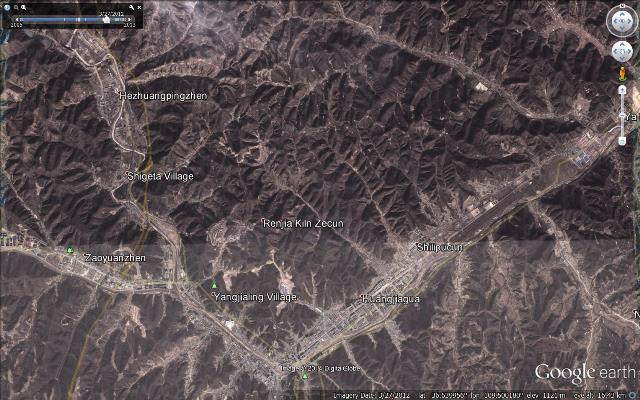5 June 2014
Moving mountains in China: a new paper in Nature
Posted by Dave Petley
Moving Mountains in China
Nature has today published an opinion piece, also covered by the BBC, about a major programme of work in China to create new land for urban development. The paper, Li et al. (2014), raises concerns about this enormous programme of work – in the city of Yan’an in Shaanxi Province for example, over 78 square kilometers of land are being created by removing the tops of mountains and filling in the surrounding valleys. Such programmes are enormously expensive, but the hope is that the cost can be recovered from sales of the land. These projects are clear on Google Earth where the imagery is up to date. This is the outskirts of Yan’an for example as shown in an image collected in 2012:
..
And this is the same site earlier this year:
..
The enormous change is clearly evident. The scale of this programme is immense – in some cases 100 – 150 metres of mountain top is being removed, and the total land area involved is 250 square kilometres.
Mountain top removal and landslides
The article raises a host of environmental concerns about this programme in China, including air and water pollution; soil erosion, subsidence, deforestation and ecosystem damage. All of these concerns are reasonable. Of course in the context of this blog, the interesting issue is the potential for landslides. And certainly there are reasons to be concerned. There are many reasons to think that such a programme might increase the risk of instability, including changes to groundwater flows and the cutting of slopes. However, in my view the greatest risks lie in the valley in-filling, which provides the potential for very rapid and highly destructive flowslides. In many other areas in which large amounts of fill has been emplaced, landslides have been common. Whilst techniques exist to mitigate these problems, they require great care and expertise. The extraordinary record of landslides associated with mining and hydroelectric power generation in China makes me wonder if the level of skill is sufficiently high to prevent accidents in such large projects. China is a very challenging environment for landslides, given the combination of steep slopes, weak materials, high levels of seasonal rainfall and intense seismicity.
The point of the Li et al. (2014) paper is to call for more research. They state:
We call on the Chinese government to accelerate research efforts urgently. With good guidance, land creation could proceed with fewer risks and more benefits.
China’s best researchers from Beijing, Shanghai and Wuhan should join regional collaborations. And a national network, similar to the National Basic Research Programs of China, should be established to coordinate this effort, to ensure quality and avoid duplication.
Scientists from the US Geological Survey, the US Environmental Protection Agency, the International Association of Hydrogeologists and universities in Canada, the United States and Europe should also be brought in. Local construction industries could be involved and provide funds and equipment.
Local and national governments should allocate funds according to scientific importance, guided by of a pool of national experts including hydrogeologists, environmentalists, economists and government officials. Extra funding must be found for environmental and ecological risk assessment and for economic studies of land creation. An independent management organization should be established and supervised by local government to manage and share the research data.”
I concur with this statement.
Reference
Li, P., Qian, H. and Wu, J. 2014. Accelerate research on land creation. Nature, 510(7503), 29-31.




 Dave Petley is the Vice-Chancellor of the University of Hull in the United Kingdom. His blog provides commentary and analysis of landslide events occurring worldwide, including the landslides themselves, latest research, and conferences and meetings.
Dave Petley is the Vice-Chancellor of the University of Hull in the United Kingdom. His blog provides commentary and analysis of landslide events occurring worldwide, including the landslides themselves, latest research, and conferences and meetings.
Very interesting project, thanks for sharing! Although i do like to see some large-scale engineering projects, this does not sound like one which makes a whole lot of sense.